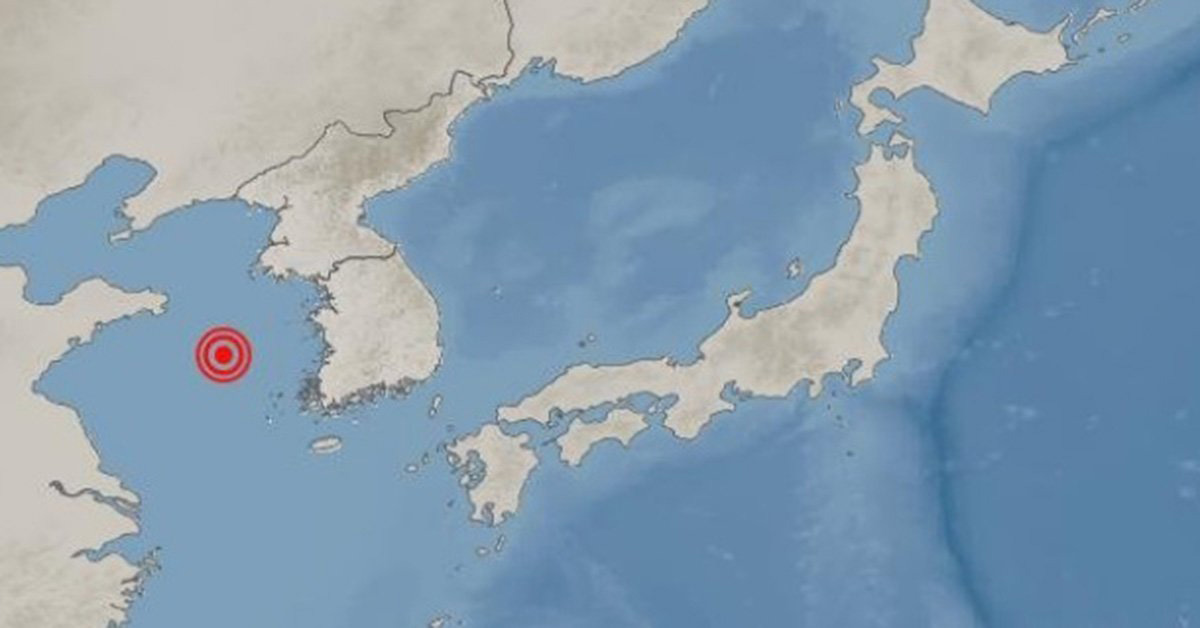
The Meteorological Administration announced that a 4.6 earthquake on the Richter scale occurred at around 3:21 am on the 19th in the 332km sea area east of Qingdao, China. A map showing the epicenter. Materials Meteorological Agency
In the early morning of the 19th, some residents of the Honam area fell asleep.
This is because a strong earthquake of 4.6 magnitude occurred at 3:21 am on the west sea, 180 km west of Eocheng Island and 332 km east of Qingdao, China.
Occurs at an intermediate point outside the territorial waters of Korea and China
Announced 1 hour after analysis cited by China Earthquake Agency
Citizens who felt vibration do not know the cause of’anxiety’
Tsushima includes early warning areas in Korea
The Meteorological Administration said, “The earthquake of the maximum magnitude II was observed in the Jeollabuk-do and North Korea regions.
In seismic intensity II, detection is possible only by a seismometer, and only sensitive people feel the vibration.
Citizens residing in some high-rise apartments in the metropolitan area, such as Seoul, felt low-frequency vibrations from the earthquake and reported them to the fire department.
Over 50 reports were received nationwide.
The Meteorological Administration released’overseas earthquake information’ at 4:13 am on the same day, about an hour after the earthquake, citing the results of the China Earthquake Administration (CEA) analysis.
The Meteorological Administration explained that the earthquake-prone area does not belong to the territorial waters of Korea or China, and is located in the area where the exclusive economic zone (EEZ) of the two countries overlap.
In the case of an overseas (overseas) earthquake, related information is provided when the scale is 5.5 or more. This earthquake is weaker than that, but the information was released considering the impact on the domestic market.
However, the residents who felt the vibration did not know the exact cause and had to experience confusion for nearly an hour at dawn.
Some experts, including Lee Yun-soo, a professor at Pohang University’s Department of Environmental Engineering, pointed out, “With this earthquake, it is necessary to further expand the domestic earthquake early warning area toward the West Sea.”
In the case of the West Sea, the water depth is shallow, so the damage from a tsunami (tsunami) is not significant, but it is necessary to prepare for a tsunami caused by a strong earthquake.
Expansion of early warning area to Tsushima

Earthquake early warning area adjusted in December 2017. The area marked with a blue line is added to the existing area (red line). Source: Meteorological Agency
Prior to this, the Meteorological Administration expanded the domestic earthquake early warning area to Tsushima, Japan in December 2017.
At the time, the Meteorological Agency said, “Even if an earthquake occurred outside of the country, such as the Kyushu Kumamoto earthquake in Japan in April 2016 (scale 7.3), early warning is needed in cases where there is a large impact on the country, the area subject to early warning is expanded.
During the April 2016 earthquake in Kyushu, Japan, vibrations were also transmitted in Busan and Gyeongnam regions, causing citizens to feel uneasy.
In the domestic early warning field, an alarm is issued when the scale is over 5.0.
Earthquake early warning refers to issuing an alert about an earthquake occurrence before the seismic wave causing earthquake damage arrives.
Among the seismic waves, the P wave propagates about 1.73 times faster than the S wave, and it takes into account the characteristics that damage occurs due to the large vibration of the S wave arriving late.

A house destroyed by an earthquake in Kumamoto Prefecture, Japan in April 2016. AP=Yonhap News
The Meteorological Agency said that it is currently testing and operating early warnings in connection with the domestic early warning system for earthquakes occurring in Kyushu, Japan.
Early warning is applied when it is expected that the observed progress in Korea will be IV or higher.
In contrast, the Meteorological Administration is skeptical about the expansion of the early warning area toward the west sea.
An official from the Meteorological Administration said, “Although China is sharing earthquake data with us, it is not meaningful as an early warning because it is usually sending it 30 minutes late due to national policy.” “I’m reviewing it.”
The Gunsan Basin is a’black box’ of geology
On the other hand, regarding the earthquake that day, Prof. Yoon-Soo Lee said, “It occurred at the boundary of the Gunsan Basin formed during the Cretaceous Period of the West Sea,” and said, “The Gunsan Basin is a place where it continues to accumulate and sink.”
Even in the early morning of April 1, 2014, an earthquake of magnitude 5.1 occurred in the waters off the coast of Taean, South Chungcheong Province, and in the 100km northwest of Seogyeokryolbido, and it was analyzed that it occurred at the boundary of the Gunsan Basin at that time.
Professor Lee said, “It can be seen that the wounds created in the Cretaceous period have not healed,” he said. “As China is also interested in the West Sea in relation to oil exploration, researchers from both Korea and China will be able to cooperate in geological investigations.”
The Gunsan Basin has been sinking over the past 100 million years, and sediments are accumulating on it, so geologists regard it as a’black box’ that contains records from the Cretaceous to the present.
Reporter Kang Chansu [email protected]
